Impact of the Anode Serpentine Channel Depth on the Performance of a Methanol Electrolysis Cell
Abstract
1. Introduction
2. Materials and Methods
3. Results
3.1. Crossover
3.2. Methanol Electrolysis Cell
3.3. Direct Methanol Fuel Cell
4. Conclusions
Author Contributions
Funding
Data Availability Statement
Conflicts of Interest
Abbreviations
| DMFC | Direct Methanol Fuel Cell |
| GDL | Gas Diffusion Layer |
| MEC | Methanol Electrolysis Cell |
| MEA | Membrane Electrode Assembly |
| OCV | Open Circuit Voltage |
| SS316L | Stainless Steel 316L |
References
- Kamarudin, S.K.; Achmad, F.; Daud, W.R.W. Overview on the application of direct methanol fuel cell (DMFC) for portable electronic devices. Int. J. Hydrogen Energy 2009, 34, 6902–6916. [Google Scholar] [CrossRef]
- Sun, C.; Negro, E.; Vezzù, K.; Pagot, G.; Cavinato, G.; Nale, A.; Bang, Y.H.; Di Noto, V. Hybrid inorganic-organic proton-conducting membranes based on SPEEK doped with WO3 nanoparticles for application in vanadium redox flow batteries. Electrochim. Acta 2019, 309, 311–325. [Google Scholar] [CrossRef]
- Chen, C.; Lu, Y.; Xing, L. Levelling renewable power output using hydrogen-based storage systems: A techno-economic analysis. J. Energy Storage 2021, 37, 102413. [Google Scholar] [CrossRef]
- Sarlak, G.; Olamaei, J.; Dosaranian-Moghadam, M. Optimal Management of Multi-Carrier Energy Hub Regarding Fuel Cell and, Storage Technologies. J. Energy Storage 2022, 46, 103821. [Google Scholar] [CrossRef]
- Marzouk, O.A. Power Density and Thermochemical Properties of Hydrogen Magnetohydrodynamic (H2MHD) Generators at Different Pressures, Seed Types, Seed Levels, and Oxidizers. Hydrogen 2025, 6, 31. [Google Scholar] [CrossRef]
- Fang, S.; Song, N.; Liu, Y.; Zhao, C.; Wang, Y. Comprehensive energy conversion efficiency analysis of micro direct methanol fuel cell stack based on polarization theory. Energy 2024, 287, 129670. [Google Scholar] [CrossRef]
- Chen, P.S.-L.; Fan, H.; Enshaei, H.; Zhang, W.; Shi, W.; Abdussamie, N.; Miwa, T.; Qu, Z.; Yang, Z. Opportunities and Challenges of Hydrogen Ports: An Empirical Study in Australia and Japan. Hydrogen 2024, 5, 436–458. [Google Scholar] [CrossRef]
- Mucci, S.; Mitsos, A.; Bongartz, D. Cost-optimal Power-to-Methanol: Flexible operation or intermediate storage? J. Energy Storage 2023, 72, 108614. [Google Scholar] [CrossRef]
- Fadzillah, D.; Kamarudin, S.; Zainoodin, M.; Masdar, M. Critical challenges in the system development of direct alcohol fuel cells as portable power supplies: An overview. Int. J. Hydrogen Energy 2019, 44, 3031–3054. [Google Scholar] [CrossRef]
- Araya, S.S.; Liso, V.; Cui, X.; Li, N.; Zhu, J.; Sahlin, S.L.; Jensen, S.H.; Nielsen, M.P.; Kær, S.K. A Review of The Methanol Economy: The Fuel Cell Route. Energies 2020, 13, 596. [Google Scholar] [CrossRef]
- Edwards, P.P.; Kuznetsov, V.L.; David, W.I.F.; Brandon, N.P. Hydrogen and fuel cells: Towards a sustainable energy future. Energy Policy 2008, 36, 4356–4362. [Google Scholar] [CrossRef]
- Roode-Gutzmer, Q.I.; Kaiser, D.; Bertau, M. Renewable Methanol Synthesis. ChemBioEng Rev. 2019, 6, 209–236. [Google Scholar] [CrossRef]
- Moellenbruck, F.; Kempken, T.; Dierks, M.; Oeljeklaus, G.; Goerner, K. Cogeneration of power and methanol based on a conventional power plant in Germany. J. Energy Storage 2018, 19, 393–401. [Google Scholar] [CrossRef]
- Shi, L.; Wang, C.; Liu, S.; Cheng, X.; Liu, Q.; Zhuge, W.; Zhang, Y. Energy optimization and economic study of an energy storage system based on a carbon dioxide-to-methanol process. J. Energy Storage 2023, 62, 106846. [Google Scholar] [CrossRef]
- Zhang, Y.; Wang, H.; Li, R.; Wang, Z.; Ling, L.; Jin, P.; Wang, H. An electro-hydrogen cogeneration system combining compressed air energy storage and methanol cracking reaction. J. Energy Storage 2023, 58, 106351. [Google Scholar] [CrossRef]
- Liu, Q.; Du, S.; Liu, T.; Gong, L.; Wu, Y.; Lin, J.; Yang, P.; Huang, G.; Li, M.; Wu, Y.; et al. Efficient Low-temperature Hydrogen Production by Electrochemical-assisted Methanol Steam Reforming. Angew. Chem. Int. Ed. Engl. 2024, 63, e202315157. [Google Scholar] [CrossRef] [PubMed]
- Ruiz-López, E.; Caravaca, A.; Vernoux, P.; Dorado, F.; de Lucas-Consuegra, A. Over-faradaic hydrogen production in methanol electrolysis cells. Chem. Eng. J. 2020, 396, 125217. [Google Scholar] [CrossRef]
- Kuramochi, N.; Yoshida-Hirahara, M.; Ogihara, H.; Kurokawa, H. Proton exchange membrane electrolysis of methanol for simultaneously synthesizing formaldehyde and hydrogen. Sustain. Energy Fuels 2023, 7, 778–785. [Google Scholar] [CrossRef]
- Gong, A.; Verstraete, D. Fuel cell propulsion in small fixed-wing unmanned aerial vehicles: Current status and research needs. Int. J. Hydrogen Energy 2017, 42, 21311–21333. [Google Scholar] [CrossRef]
- Eqbal, M.A.S.; Fernando, N.; Marino, M.; Wild, G. Hybrid Propulsion Systems for Remotely Piloted Aircraft Systems. Aerospace 2018, 5, 34. [Google Scholar] [CrossRef]
- Kim, T.; Kwon, S. Design and development of a fuel cell-powered small unmanned aircraft. Int. J. Hydrogen Energy 2012, 37, 615–622. [Google Scholar] [CrossRef]
- Yagiz, M.; Çelik, S.; Topcu, A. Performance comparison of bio-inspired flow field designs for direct methanol fuel cell and proton exchange membrane fuel cell. Int. J. Hydrogen Energy 2024, 75, 200–210. [Google Scholar] [CrossRef]
- Sesu, D.C.; Narendran, G.; Ramakrishnan, S.; Vediappan, K.; Muthu, S.E.; Shanmugan, S.; Kannan, K. Design and Fabrication of Micro-Electromechanical System (MEMS)-Based μ-DMFC (Direct Methanol Fuel Cells) for Portable Applications: An Outlook. Electrochem 2025, 6, 11. [Google Scholar] [CrossRef]
- Ahmed, M.; Dincer, I. A review on methanol crossover in direct methanol fuel cells: Challenges and achievements. Int. J. Energy Res. 2011, 35, 1213–1228. [Google Scholar] [CrossRef]
- Goor, M.; Menkin, S.; Peled, E. High power direct methanol fuel cell for mobility and portable applications. Int. J. Hydrogen Energy 2019, 44, 3138–3143. [Google Scholar] [CrossRef]
- Alias, M.; Kamarudin, S.; Zainoodin, A.; Masdar, M. Active direct methanol fuel cell: An overview. Int. J. Hydrogen Energy 2020, 45, 19620–19641. [Google Scholar] [CrossRef]
- Barbera, O.; Stassi, A.; Sebastian, D.; Bonde, J.; Giacoppo, G.; D’Urso, C.; Baglio, V.; Arico’, A.S. Simple and functional direct methanol fuel cell stack designs for application in portable and auxiliary power units. Int. J. Hydrogen Energy 2016, 41, 12320–12329. [Google Scholar] [CrossRef]
- Baglio, V.; Stassi, A.; Matera, F.; Antonucci, V.; Aricò, A. Investigation of passive DMFC mini-stacks at ambient temperature. Electrochim. Acta 2009, 54, 2004–2009. [Google Scholar] [CrossRef]
- Wang, L.; He, M.; Hu, Y.; Zhang, Y.; Liu, X.; Wang, G. A “4-cell” modular passive DMFC (direct methanol fuel cell) stack for portable applications. Energy 2015, 82, 229–235. [Google Scholar] [CrossRef]
- Kim, D.; Lee, J.; Lim, T.-H.; Oh, I.-H.; Ha, H.Y. Operational characteristics of a 50 W DMFC stack. J. Power Sources 2006, 155, 203–212. [Google Scholar] [CrossRef]
- Joh, H.-I.; Hwang, S.Y.; Cho, J.H.; Ha, T.J.; Kim, S.-K.; Moon, S.H.; Ha, H.Y. Development and characteristics of a 400 W-class direct methanol fuel cell stack. Int. J. Hydrogen Energy 2008, 33, 7153–7162. [Google Scholar] [CrossRef]
- Berretti, E.; Osmieri, L.; Baglio, V.; Miller, H.A.; Filippi, J.; Vizza, F.; Santamaria, M.; Specchia, S.; Santoro, C.; Lavacchi, A. Direct Alcohol Fuel Cells: A Comparative Review of Acidic and Alkaline Systems. Electrochem. Energy Rev. 2023, 6, 30. [Google Scholar] [CrossRef]
- Villalba-Herreros, A.; Santiago, Ó.; Abad, R.; Leo, T.J. Carbon dioxide treatment method for autonomous underwater vehicles powered by direct methanol fuel cells: A multi-criteria decision analysis approach. J. Power Sources 2021, 512, 230322. [Google Scholar] [CrossRef]
- Ozden, A.; Ercelik, M.; Ouellette, D.; Colpan, C.O.; Ganjehsarabi, H.; Hamdullahpur, F. Designing, modeling and performance investigation of bio-inspired flow field based DMFCs. Int. J. Hydrogen Energy 2017, 42, 21546–21558. [Google Scholar] [CrossRef]
- Oliveira, V.; Rangel, C.; Pinto, A. Effect of anode and cathode flow field design on the performance of a direct methanol fuel cell. Chem. Eng. J. 2010, 157, 174–180. [Google Scholar] [CrossRef]
- Chen, M.; Wang, M.; Yang, Z.; Ding, X.; Wang, X. Long-term degradation behaviors research on a direct methanol fuel cell with more than 3000 h lifetime. Electrochim. Acta 2018, 282, 702–710. [Google Scholar] [CrossRef]
- Ouellette, D.; Ozden, A.; Ercelik, M.; Colpan, C.O.; Ganjehsarabi, H.; Li, X.; Hamdullahpur, F. Assessment of different bio-inspired flow fields for direct methanol fuel cells through 3D modeling and experimental studies. Int. J. Hydrogen Energy 2018, 43, 1152–1170. [Google Scholar] [CrossRef]
- Aricò, A.; Cretì, P.; Baglio, V.; Modica, E.; Antonucci, V. Influence of flow field design on the performance of a direct methanol fuel cell. J. Power Sources 2000, 91, 202–209. [Google Scholar] [CrossRef]
- Vijayakumar, R.; Rajkumar, M.; Sridhar, P.; Pitchumani, S. Effect of anode and cathode flow field depths on the performance of liquid feed direct methanol fuel cells (DMFCs). J. Appl. Electrochem. 2012, 42, 319–324. [Google Scholar] [CrossRef]
- Jung, D.Y.; Song, D.K.; Kim, J.S.; Lee, S.H.; Min, G.W.; Son, J.H.; Cho, G.Y. Numerical Investigation of Effects of Obstacles in Flow Channels and Depth of Flow Channels for PEMFCs. Sustainability 2024, 16, 10144. [Google Scholar] [CrossRef]
- Pham, A.T.; Baba, T.; Shudo, T. Efficient hydrogen production from aqueous methanol in a PEM electrolyzer with porous metal flow field: Influence of change in grain diameter and material of porous metal flow field. Int. J. Hydrogen Energy 2013, 38, 9945–9953. [Google Scholar] [CrossRef]
- Yuan, Z.; Zhang, Y.; Fu, W.; Li, Z.; Liu, X. Investigation of a small-volume direct methanol fuel cell stack for portable applications. Energy 2013, 51, 462–467. [Google Scholar] [CrossRef]
- Yang, H.; Zhao, T. Effect of anode flow field design on the performance of liquid feed direct methanol fuel cells. Electrochim. Acta 2005, 50, 3243–3252. [Google Scholar] [CrossRef]
- Ramasamy, J.; Palaniswamy, K.; Kumaresan, T.; Chandran, M.; Chen, R. Study of novel flow channels influence on the performance of direct methanol fuel cell. Int. J. Hydrogen Energy 2022, 47, 595–609. [Google Scholar] [CrossRef]
- Chowdhury, P.R.; Gladen, A.C. Empirical Comparison of Flow Field Designs for Direct Ethanol-Based, High-Temperature PEM Fuel Cells. Fuels 2025, 6, 46. [Google Scholar] [CrossRef]
- Vuppala, R.K.S.S.; Chaedir, B.A.; Jiang, L.; Chen, L.; Aziz, M.; Sasmito, A.P. Optimization of Membrane Electrode Assembly of PEM Fuel Cell by Response Surface Method. Molecules 2019, 24, 3097. [Google Scholar] [CrossRef] [PubMed]
- Song, Y.; Zhang, C.; Ling, C.-Y.; Han, M.; Yong, R.-Y.; Sun, D.; Chen, J. Review on current research of materials, fabrication and application for bipolar plate in proton exchange membrane fuel cell. Int. J. Hydrogen Energy 2020, 45, 29832–29847. [Google Scholar] [CrossRef]
- Scott, K.; Argyropoulos, P.; Yiannopoulos, P.; Taama, W. Electrochemical and gas evolution characteristics of direct methanol fuel cells with stainless steel mesh flow beds. J. Appl. Electrochem. 2001, 31, 823–832. [Google Scholar] [CrossRef]
- Tawfik, H.; Hung, Y.; Mahajan, D. Metal bipolar plates for PEM fuel cell—A review. J. Power Sources 2007, 163, 755–767. [Google Scholar] [CrossRef]
- Yu, B.; Yang, Q.; Kianimanesh, A.; Freiheit, T.; Park, S.; Zhao, H.; Xue, D. A CFD model with semi-empirical electrochemical relationships to study the influence of geometric and operating parameters on DMFC performance. Int. J. Hydrogen Energy 2013, 38, 9873–9885. [Google Scholar] [CrossRef]
- Calabriso, A.; Borello, D.; Cedola, L.; Del Zotto, L.; Santori, S.G. Assessment of CO2 Bubble Generation Influence on Direct Methanol Fuel Cell Performance. Energy Procedia 2015, 75, 1996–2002. [Google Scholar] [CrossRef]
- Calabriso, A.; Borello, D.; Romano, G.P.; Cedola, L.; Del Zotto, L.; Santori, S.G. Bubbly flow mapping in the anode channel of a direct methanol fuel cell via PIV investigation. Appl. Energy 2017, 185, 1245–1255. [Google Scholar] [CrossRef]
- Park, Y.-C.; Chippar, P.; Kim, S.-K.; Lim, S.; Jung, D.-H.; Ju, H.; Peck, D.-H. Effects of serpentine flow-field designs with different channel and rib widths on the performance of a direct methanol fuel cell. J. Power Sources 2012, 205, 32–47. [Google Scholar] [CrossRef]
- Carey, V.P. Liquid-Vapor Phase-Change Phenomena: An Introduction to the Thermophysics of Vaporization and Condensation Processes in Heat Transfer Equipment. In Liquid-Vapor Phase-Change Phenomena, 3rd ed; CRC Press: Boca Raton, FL, USA, 2020. [Google Scholar] [CrossRef]
- Uhm, S.; Jeon, H.; Kim, T.J.; Lee, J. Clean hydrogen production from methanol–water solutions via power-saved electrolytic reforming process. J. Power Sources 2012, 198, 218–222. [Google Scholar] [CrossRef]
- Sasikumar, G.; Muthumeenal, A.; Pethaiah, S.; Nachiappan, N.; Balaji, R. Aqueous methanol eletrolysis using proton conducting membrane for hydrogen production. Int. J. Hydrogen Energy 2008, 33, 5905–5910. [Google Scholar] [CrossRef]
- Take, T.; Tsurutani, K.; Umeda, M. Hydrogen production by methanol–water solution electrolysis. J. Power Sources 2007, 164, 9–16. [Google Scholar] [CrossRef]
- Meca, V.L.; D’aMore-Domenech, R.; Crucelaegui, A.; Leo, T.J. Large-Scale Maritime Transport of Hydrogen: Economic Comparison of Liquid Hydrogen and Methanol. ACS Sustain. Chem. Eng. 2022, 10, 4300–4311. [Google Scholar] [CrossRef]
- Li, L.; Zhang, L.; Gou, L.; Wei, S.; Hou, X.; Wu, L. High-performance methanol electrolysis towards energy-saving hydrogen production: Using Cu2O-Cu decorated Ni2P nanoarray as bifunctional monolithic catalyst. Chem. Eng. J. 2023, 454, 140292. [Google Scholar] [CrossRef]
- Sanchez, C.; Espinos, F.J.; Barjola, A.; Escorihuela, J.; Compañ, V. Hydrogen Production from Methanol–Water Solution and Pure Water Electrolysis Using Nanocomposite Perfluorinated Sulfocationic Membranes Modified by Polyaniline. Polymers 2022, 14, 4500. [Google Scholar] [CrossRef] [PubMed]
- Pham, A.T.; Baba, T.; Sugiyama, T.; Shudo, T. Efficient hydrogen production from aqueous methanol in a PEM electrolyzer with porous metal flow field: Influence of PTFE treatment of the anode gas diffusion layer. Int. J. Hydrogen Energy 2013, 38, 73–81. [Google Scholar] [CrossRef]
- Lamy, C.; Coutanceau, C.; Baranton, S. Production of hydrogen by the electrocatalytic oxidation of low-weight compounds (HCOOH, MeOH, EtOH). In Production of Clean Hydrogen by Electrochemical Reforming of Oxygenated Organic Compounds; Elsevier: San Diego, CA, USA, 2020; pp. 37–79. [Google Scholar] [CrossRef]
- Sethu, S.P.; Gangadharan, S.; Chan, S.H.; Stimming, U. Development of a novel cost effective methanol electrolyzer stack with Pt-catalyzed membrane. J. Power Sources 2014, 254, 161–167. [Google Scholar] [CrossRef]
- Pethaiah, S.S.; Sadasivuni, K.K.; Jayakumar, A.; Ponnamma, D.; Tiwary, C.S.; Sasikumar, G. Methanol Electrolysis for Hydrogen Production Using Polymer Electrolyte Membrane: A Mini-Review. Energies 2020, 13, 5879. [Google Scholar] [CrossRef]
- Hu, Z.; Wu, M.; Wei, Z.; Song, S.; Shen, P.K. Pt-WC/C as a cathode electrocatalyst for hydrogen production by methanol electrolysis. J. Power Sources 2007, 166, 458–461. [Google Scholar] [CrossRef]
- Egea, J.R.J.; Martín, E.C.; Bas, M.T.C. Procedimiento de Obtención de Recubrimiento Mediante Técnica de Aerografiado Automático a Partir de Suspensiones de Polvos Nanométricos o Soles Obtenidos vía Sol-Gel y Dispositivo Para su Puesta a Punto, 2209657. 2004. Available online: https://worldwide.espacenet.com/publicationDetails/originalDocument?FT=D&date=20040616&DB=EPODOC&locale=&CC=ES&NR=2209657A1&KC=A1&ND=2 (accessed on 20 December 2023).
- Leo, T.; Raso, M.; Navarro, E.; de la Blanca, E.S.; Villanueva, M.; Moreno, B. Response of a direct methanol fuel cell to fuel change. Int. J. Hydrogen Energy 2010, 35, 11642–11648. [Google Scholar] [CrossRef]
- Meca, V.L.; D’Amore-Domenech, R.; Villalba-Herreros, A.; Leo, T.J. Test bench for electricity or hydrogen production from aqueous methanol. In Proceedings of the 36th International Conference on Efficiency, Cost, Optimization, Simulation and Environmental Impact of Energy Systems, Las Palmas de Gran Canaria, Spain, 25–30 June 2023; pp. 1104–1109. [Google Scholar] [CrossRef]
- Ren, X.; Springer, T.E.; Zawodzinski, T.A.; Gottesfeld, S. Methanol Transport Through Nation Membranes. Electro-osmotic Drag Effects on Potential Step Measurements. J. Electrochem. Soc. 2000, 147, 466. [Google Scholar] [CrossRef]
- Santiago, Ó.; Mosa, J.; Escribano, P.; Navarro, E.; Chinarro, E.; Aparicio, M.; Leo, T.; del Río, C. 40SiO2–40P2O5–20ZrO2 sol-gel infiltrated sSEBS membranes with improved methanol crossover and cell performance for direct methanol fuel cell applications. Int. J. Hydrogen Energy 2020, 45, 20620–20631. [Google Scholar] [CrossRef]
- Basile, A.; Dalena, F. Methanol: Science and Engineering, 1st ed.; Elsevier: Amsterdam, The Netherlands, 2017. [Google Scholar]
- Pinto, A.M.F.R.; Oliveira, V.B.; Falcão, D.S. Direct Alcohol Fuel Cells for Portable Applications: Fundamentals, Engineering and Advances; Academic Press: Cambridge, MA, USA, 2018. [Google Scholar] [CrossRef]
- Park, J.-Y.; Seo, Y.; Kang, S.; You, D.; Cho, H.; Na, Y. Operational characteristics of the direct methanol fuel cell stack on fuel and energy efficiency with performance and stability. Int. J. Hydrogen Energy 2012, 37, 5946–5957. [Google Scholar] [CrossRef]
- Lamy, C.; Guenot, B.; Cretin, M.; Pourcelly, G. (Invited) A Kinetics Analysis of Methanol Oxidation under Electrolysis/Fuel Cell Working Conditions. ECS Trans. 2015, 66, 1–12. [Google Scholar] [CrossRef]
- Yang, H.; Zhao, T.; Ye, Q. In situ visualization study of CO2 gas bubble behavior in DMFC anode flow fields. J. Power Sources 2005, 139, 79–90. [Google Scholar] [CrossRef]
- Su, X.; Yuan, W.; Lu, B.; Zheng, T.; Ke, Y.; Zhuang, Z.; Zhao, Y.; Tang, Y.; Zhang, S. CO2 bubble behaviors and two-phase flow characteristics in single-serpentine sinusoidal corrugated channels of direct methanol fuel cell. J. Power Sources 2020, 450, 227621. [Google Scholar] [CrossRef]
- Yuan, W.; Wang, A.; Ye, G.; Pan, B.; Tang, K.; Chen, H. Dynamic relationship between the CO2 gas bubble behavior and the pressure drop characteristics in the anode flow field of an active liquid-feed direct methanol fuel cell. Appl. Energy 2017, 188, 431–443. [Google Scholar] [CrossRef]
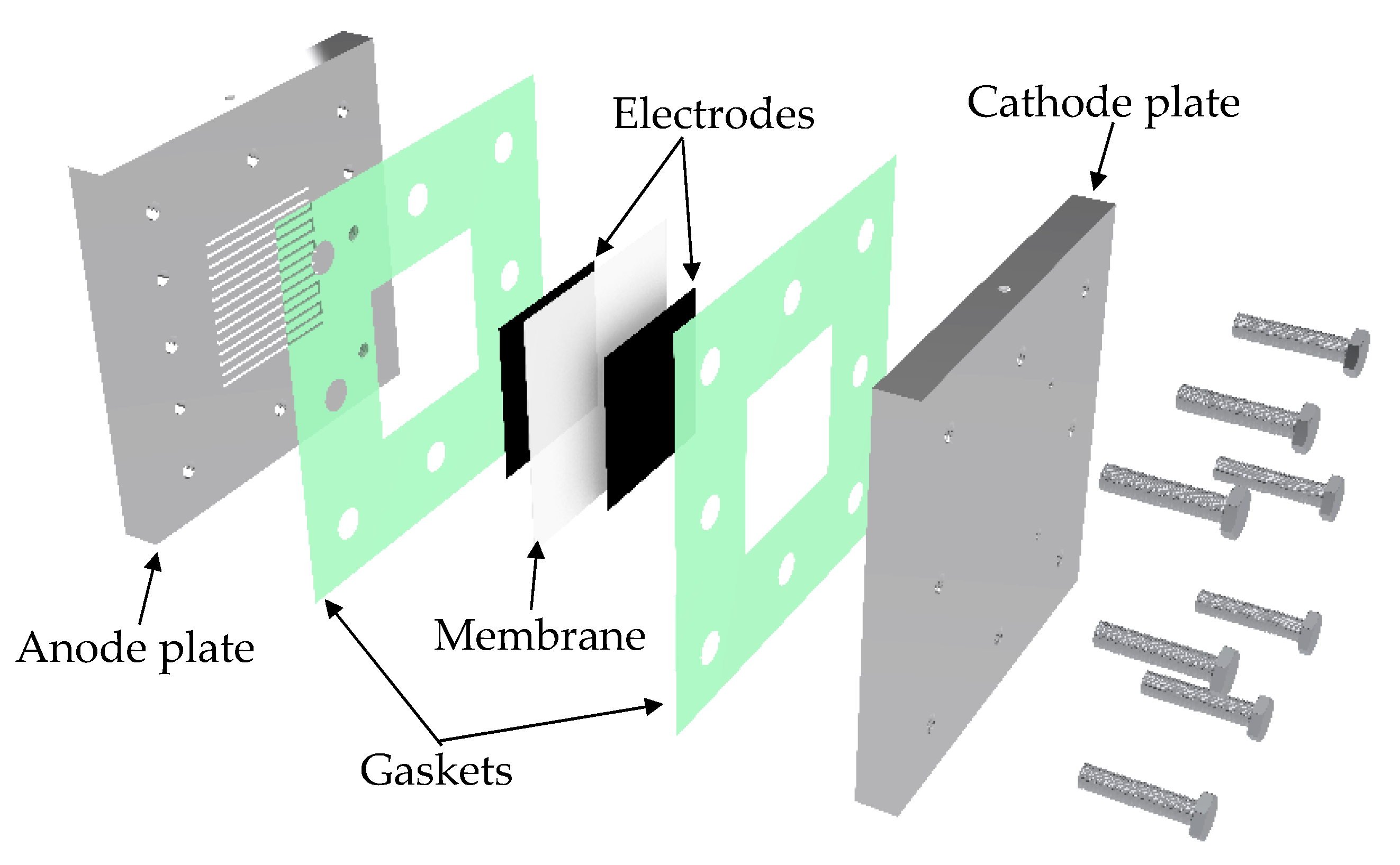

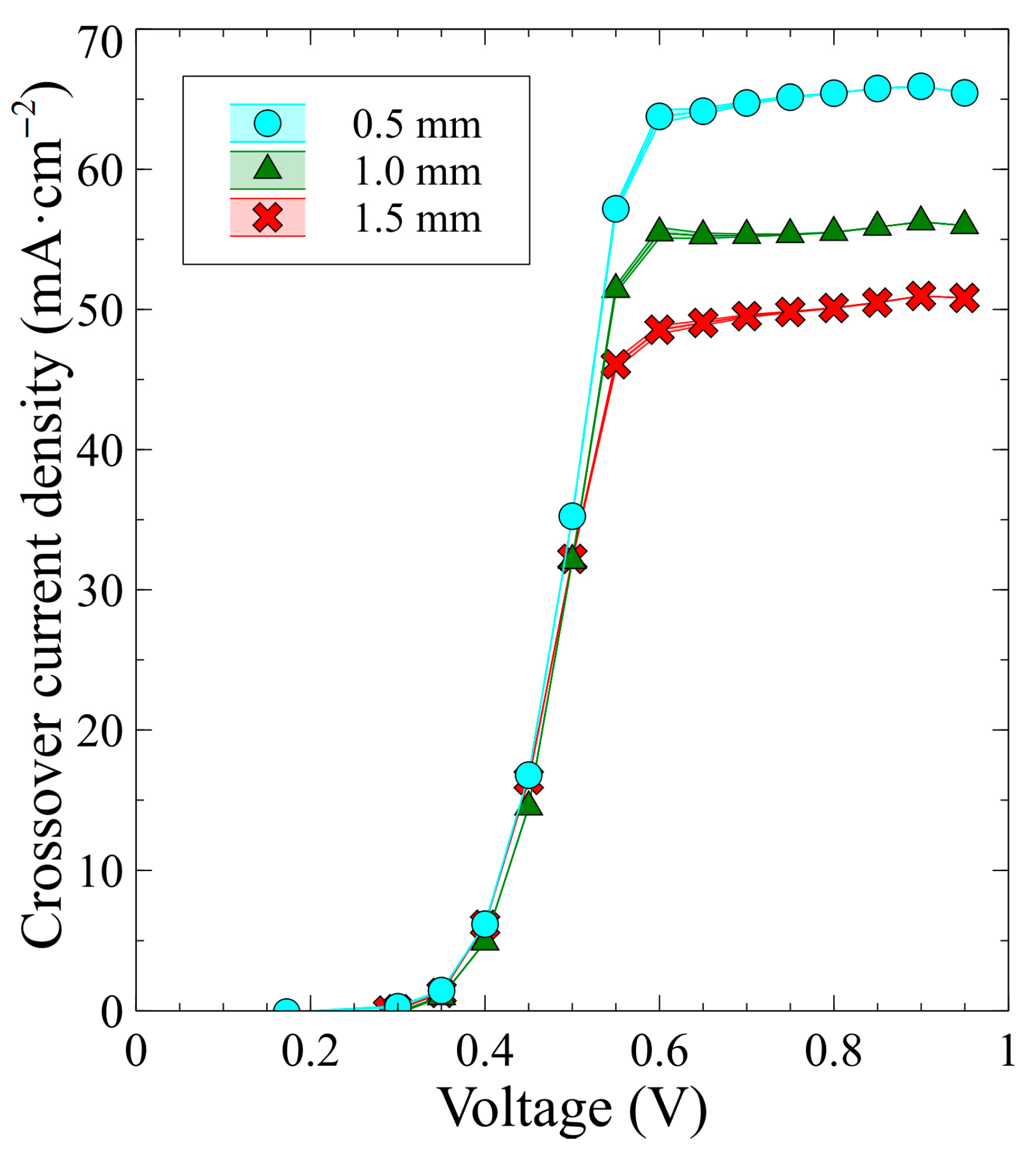
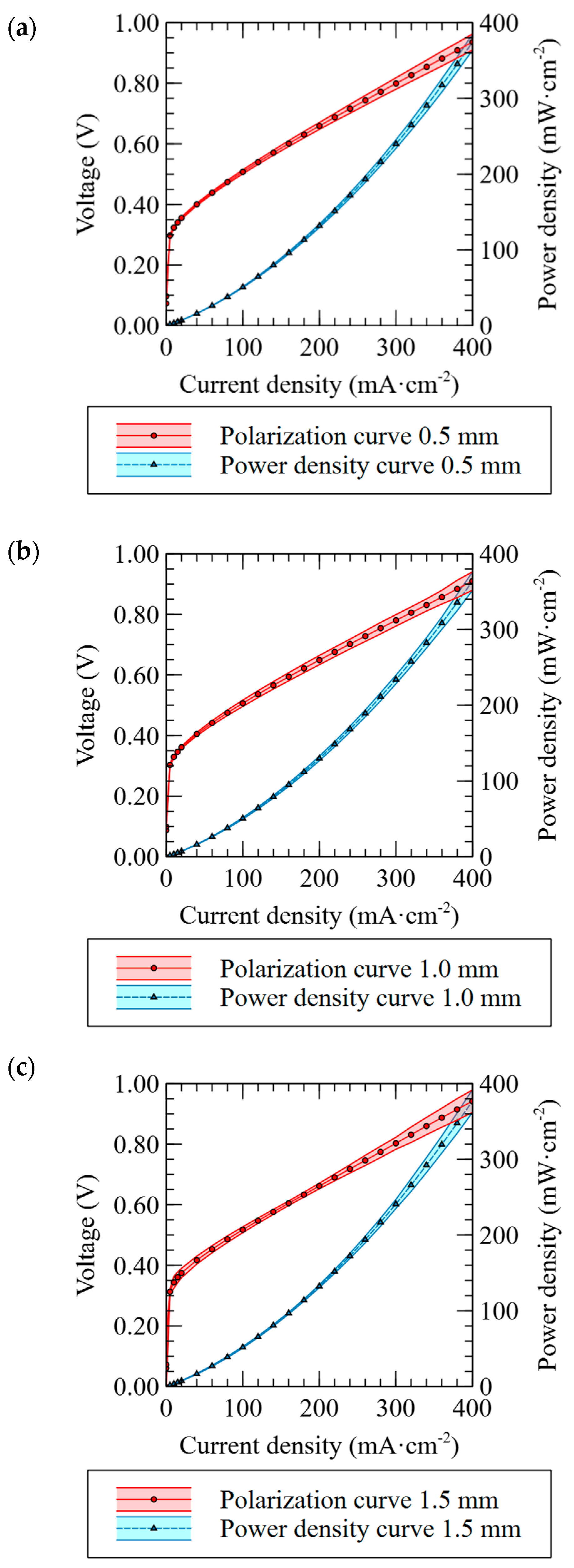
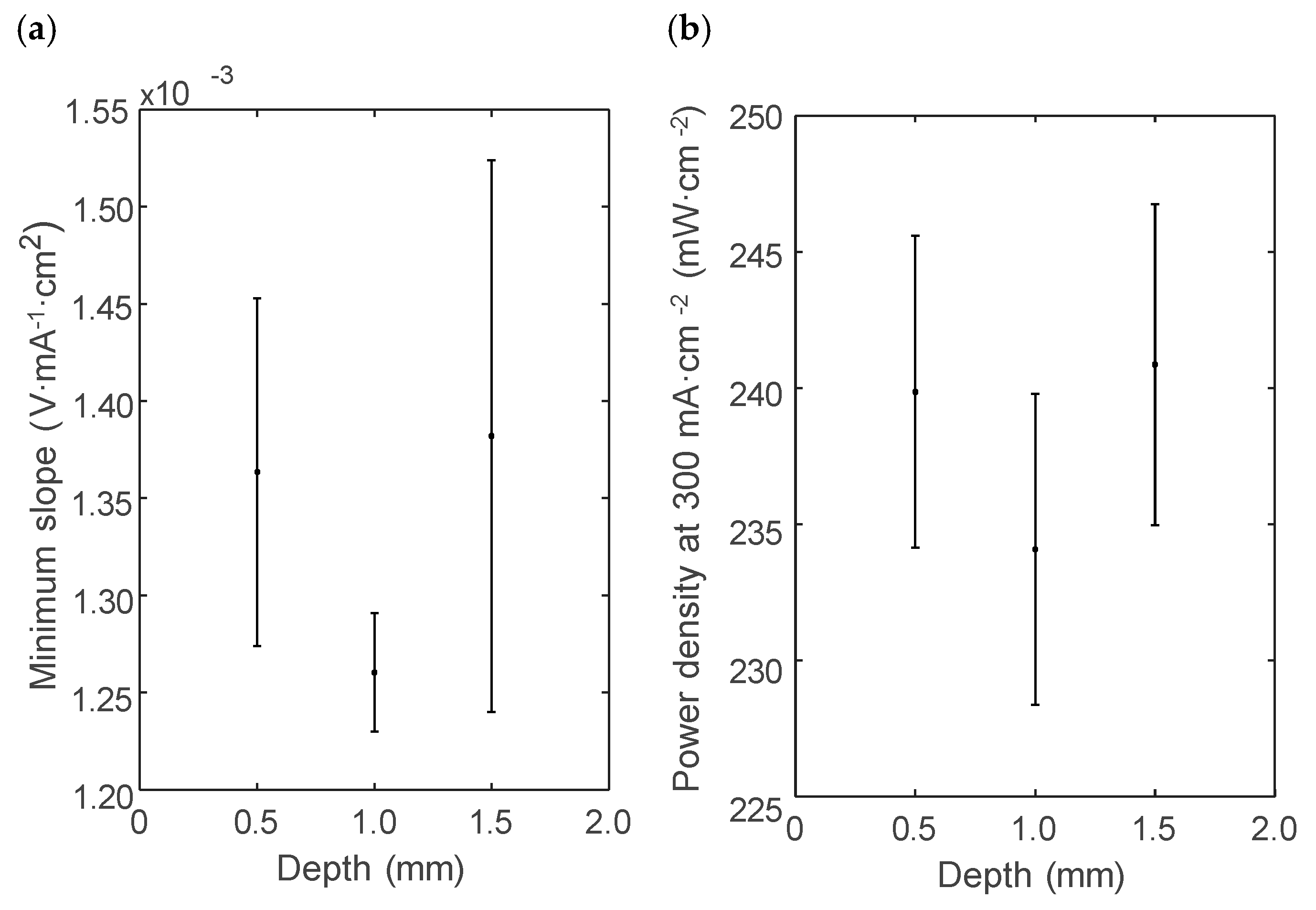
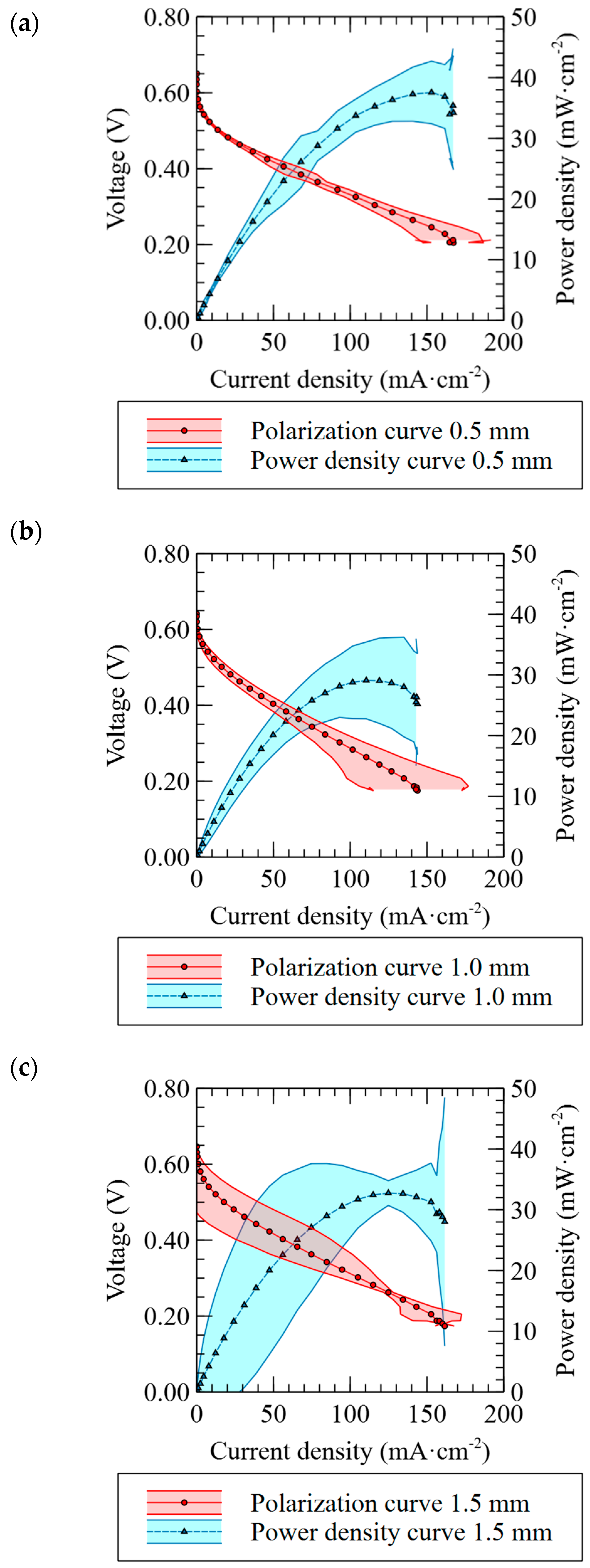
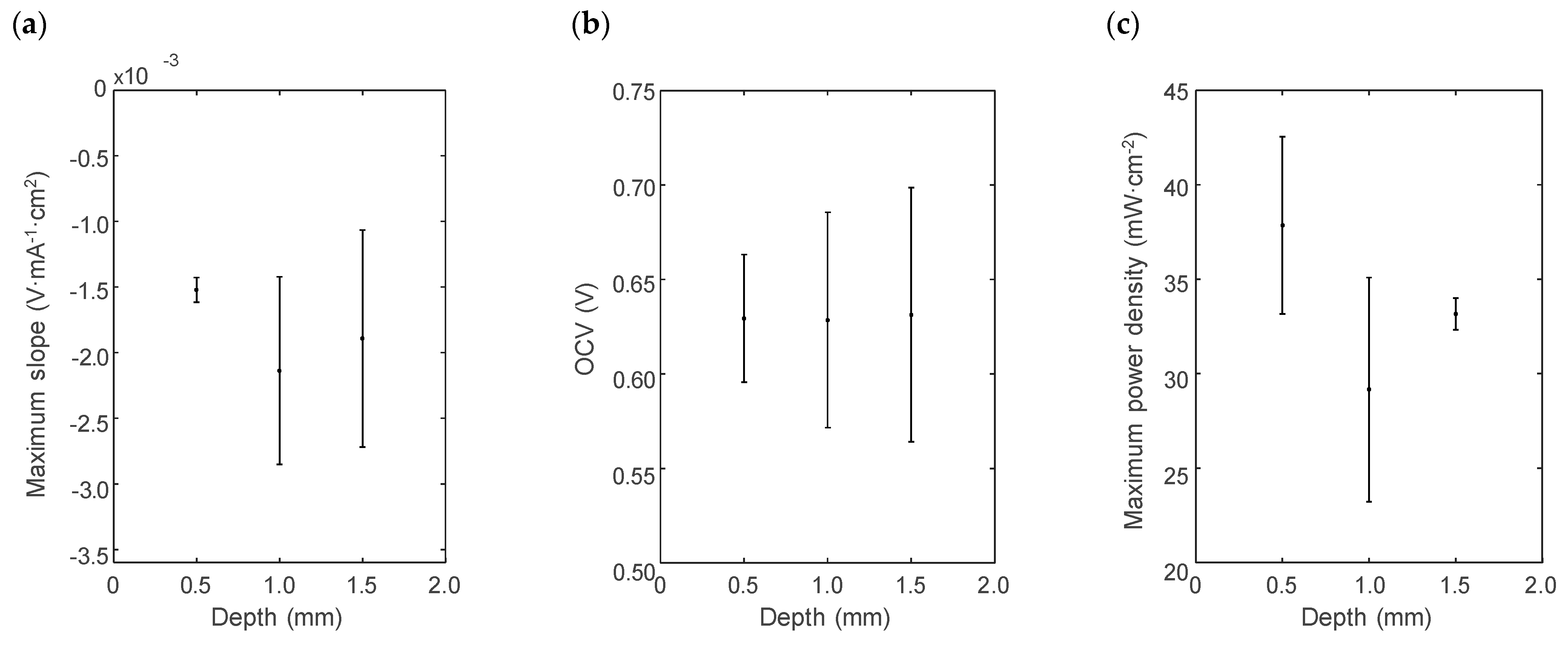
| Parameter | Plate 1 | Plate 2 | Plate 3 |
|---|---|---|---|
| Depth of anode channel, mm | 0.5 | 1.0 | 1.5 |
| Depth of cathode channel, mm | 0.5 | 0.5 | 0.5 |
| Material of the plates | SS316L | SS316L | SS316L |
| Number of channel bends | 24 | 24 | 24 |
| Width of anode channel, mm | 1.0 | 1.0 | 1.0 |
| Open Ratio of anode channel | 0.624 | 0.624 | 0.624 |
| Contact surface treatment | N3 | N3 | N3 |
| Parameter | DMFC | MEC |
|---|---|---|
| Temperature, °C | 60 | 60 |
| Methanol concentration, mol·L−1 | 1 | 1 |
| Methanol flow rate, mL·min−1 | 3 | 3 |
| Methanol supplier | Panreac AppliedChem (99.9%) | Panreac AppliedChem (99.9%) |
| Oxygen flow rate, mL·min−1 | 110 | - |
| Oxygen pressure, MPa | 0.1 | - |
| Anode catalyst | Pt/Ru, molar ratio 1:1 | Pt/Ru, molar ratio 1:1 |
| Anode catalyst charge, mg·cm−2 | 3 | 3 |
| Anode commercial reference | BC-H225-10F | - |
| Anode supplier | Quintech | - |
| Cathode catalyst | Pt | Pt |
| Cathode catalyst charge, mg·cm−2 | 1 | 1 |
| Cathode commercial reference | BC-M100-30F | - |
| Cathode supplier | Quintech | - |
Disclaimer/Publisher’s Note: The statements, opinions and data contained in all publications are solely those of the individual author(s) and contributor(s) and not of MDPI and/or the editor(s). MDPI and/or the editor(s) disclaim responsibility for any injury to people or property resulting from any ideas, methods, instructions or products referred to in the content. |
© 2025 by the authors. Licensee MDPI, Basel, Switzerland. This article is an open access article distributed under the terms and conditions of the Creative Commons Attribution (CC BY) license (https://creativecommons.org/licenses/by/4.0/).
Share and Cite
Meca, V.L.; Posada, E.; Villalba-Herreros, A.; d’Amore-Domenech, R.; Leo, T.J.; Santiago, Ó. Impact of the Anode Serpentine Channel Depth on the Performance of a Methanol Electrolysis Cell. Hydrogen 2025, 6, 51. https://doi.org/10.3390/hydrogen6030051
Meca VL, Posada E, Villalba-Herreros A, d’Amore-Domenech R, Leo TJ, Santiago Ó. Impact of the Anode Serpentine Channel Depth on the Performance of a Methanol Electrolysis Cell. Hydrogen. 2025; 6(3):51. https://doi.org/10.3390/hydrogen6030051
Chicago/Turabian StyleMeca, Vladimir L., Elena Posada, Antonio Villalba-Herreros, Rafael d’Amore-Domenech, Teresa J. Leo, and Óscar Santiago. 2025. "Impact of the Anode Serpentine Channel Depth on the Performance of a Methanol Electrolysis Cell" Hydrogen 6, no. 3: 51. https://doi.org/10.3390/hydrogen6030051
APA StyleMeca, V. L., Posada, E., Villalba-Herreros, A., d’Amore-Domenech, R., Leo, T. J., & Santiago, Ó. (2025). Impact of the Anode Serpentine Channel Depth on the Performance of a Methanol Electrolysis Cell. Hydrogen, 6(3), 51. https://doi.org/10.3390/hydrogen6030051









